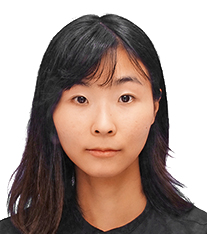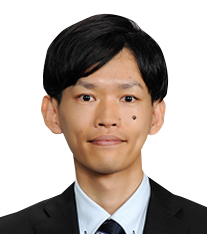- JST Home
- /
- Strategic Basic Research Programs
- /
 PRESTO
PRESTO- /
- project/
- Nano Materials for New Principle Devices/
- [Nano materials devices] Year Started : 2024
[Nano materials devices] Year Started : 2024
Taiki Inoue
Chemical vapor deposition-based fabrication of atimic layer materials devices
Grant No.:JPMJPR24H1
Researcher
Taiki Inoue

Assistant Professor
Graduate School of Engineering
The University of Osaka
Outline
Atomic layer materials such as graphene, hexagonal boron nitride, and transition metal dichalcogenides are expected as builiding blocks of next-generation semiconductor devices. In this research project, I aim to establish a new fabrication strategy for atomic layer material devices by integrating conventional semiconductor processes with advanced material synthesis techniques such as heterolayer growth, growth and etching rate control, and nucleation control in chemical vapor deposition of atomic layer materials.
Mengnan Ke
Developing a Technological Basis for Next-Generation Material Devices in 3D Integrated CFET
Grant No.:JPMJPR24H2
Researcher
Mengnan Ke

Associate Professor
Institute for Multidisciplinary Sciences
Yokohama National University
Outline
To achieve the realization of CFET with next generation channel materials, this project aims to develop 3D integrated CMOS using Ge and two-dimensional material semiconductors and their stacked structures. It successfully designs and develops the world’s first 3D integrated CMOS employing Ge pFET and MoS2 nFET, with the establishment of key technologies such as high-quality Ge and MoS2 MOS interfaces formation, stacked MoS2 channel formation via transfer methods, and low-resistance source/drain contacts formation enabling direct 3D connection. The optimal structures and processes for these devices will also be clarified.
Daisuke Kan
Polarization control of two-dimensional ferroelectrics and device applications
Grant No.:JPMJPR24H3
Researcher
Daisuke Kan

Professor
Graduate School of Engineering
The University of Osaka
Outline
Two-dimensional ferroelectrics are nanomaterials that can maintain spontaneous polarization even when thinned down to the thickness of one or two unit cells of their crystal lattices (approximately 1 nanometer). In this research project, we will develop techniques for two-dimensional ferroelectrics and utilize approaches that have not been available in previous ferroelectric material research, such as twist stacking, to control spontaneous polarization and achieve superior properties. We aim to realize a two-dimensional ferroelectric material with superior properties and develop ultra-low power consumption memory devices.
Yuya Shimazaki
Construction of moire molecular science
Grant No.:JPMJPR24H4
Researcher
Yuya Shimazaki

Associate Professor
The Institute for Solid State Physics
The University of Tokyo
Outline
In this project, I plan to realize highly uniform few electron states in heterostructures of semiconductor transitional dichalcogenides by combining weak gate-confinement and strong moiré potential. Especially, I plan to detect single electron states using trion photoluminescence, trion excitation spectroscopy, and also quanutm optical measurements. Finally, I plan to realize moiré molecules composed of few electrons using gate electrode control.
Katsuaki Sugawara
Development of novel atomic-layer nanomaterials by integration of nano measurement and molecular-beam epitaxy
Grant No.:JPMJPR24H5
Researcher
Katsuaki Sugawara

Associate Professor
Graduate School of Science and Faculty of Science
Tohoku University
Outline
In this PRESTO project, I aim to fabricate new atomic-layer nanomaterials by using MBE, atomic replacement, and precipitation methods, and clarify their novel quantum physical properties. Also, To elucidate the mechanism of these physical phenomena through electronic structure imaging using nano-measurements such as micro-/nano-ARPES will discover novel quantum phenomena in atomic-layer materials. From the experimental results, I will contribute to developing new functional nanodevices called “atomic-layer electronics” based on atomic-layer nanomaterials.
Yutaro Takeuchi
Novel functionalities of nanoscale spin devices with topological antiferromagnetic thin films
Grant No.:JPMJPR24H6
Researcher
Yutaro Takeuchi

Researcher
Research Center for Magnetic and Spintronic Materials
National Institute for Materials Science
Outline
The discovery of quantum intriguing effects in topological antiferromagnets has accelerated research on spin devices using antiferromagnets as core materials. Here, we utilize the current-induced spin rotation of topological antiferromagnets in nanoscale devices. In particular, we will demonstrate the ultrafast spin switching and oscillation effects, which are qualitatively different from spin devices with conventional ferromagnets. This research aims to create core technologies for developping high-performance nonvolatile memories and high-speed communication devices.
Miuko Tanaka
Exploring new phenomena of van der Waals materials using microwave
Grant No.:JPMJPR24H7
Researcher
Miuko Tanaka

Research Assoicate
Institute for Solid State Physics
The University of Tokyo
Outline
Van der Waals materials are an ideal platform for condensed matter physics, as they allow the creation of desired physical systems by combining multiple materials. However, due to their extremely small volume, measurement methods have been limited so far. In the previously unexplored energy range of MHz to GHz, important physics related to superconductors and magnetic materials exist. In this study, I establish a method for measuring the microwave response of atomic layer materials and explore new phenomena related to superconductivity and magnetism.
Yijin Zhang
Micro-spectroscopy of two-dimensional materials devices
Grant No.:JPMJPR24H8
Researcher
Yijin Zhang

Associate Professor
Graduate School of Science
The University of Tokyo
Outline
In this study I investigate unexplored areas of nano devices composed of two-dimensional materials and their van der Waals assemblies by optical micro-spectroscopy. I will explore optical and opto-electrical properties and functionalities of nano devices at ultra-low temperature and under high magnetic field. These areas have remained unexplored because of the difficulty in measurement technique, which can be overcame by my own-built system that enables simultaneous measurements of electrical transport and optical micro-spectroscopy. In addition, I will construct a unique van der Waals assembly system, which is compatible with optical micro-spectrometer. With this system, I will try to establish a new research style of in-situ characterization during van der Waals assembly.
Takahiro Fujita
Exploration of Interfacial Emergent Magnetotransport Phenomena toward Device Application
Grant No.:JPMJPR24H9
Researcher
Takahiro Fujita

Research Scientist
Center for Emergent Matter Science
RIKEN
Outline
Electrons in topologically non-trivial magnetic structures are driven by virtual emergent magnetic fields, exhibiting various emergent magnetotransport phenomena. In this research, we explore new functionalities and novel physical phenomena induced by the emergent magnetic fields at oxide heterointerfaces, where electrical conductivity and magnetism are functionally separated. These interfaces enable investigations impossible in conventional bulk materials. We aim to elevate oxide heterointerfaces to a novel research platform for “interfacial” emergent magnetotransport phenomena. To achieve this, we will develop a growth method that achieves high crystallinity and is adaptable to a wide range of materials.
Michio Matsumoto
Organic semiconductive materials with geometrical frustration
Grant No.:JPMJPR24HA
Researcher
Michio Matsumoto

Researcher
Research center for Materials Nanoarchtechtonics
National Institute for Materials Science
Outline
Geometrical frustration introduces complexity into symple material structures and derives unique physical properties. Despite successful examples in inorganic materials with metal ions, there are few examples of geometrical frustration in organic molecular crystals. The aim of this study is to develop a new method to synthesize organic semi-conductive molecular crystals with geometrical frustration by using molecular gears and to investigate the physical properties of the resulting new materials.













